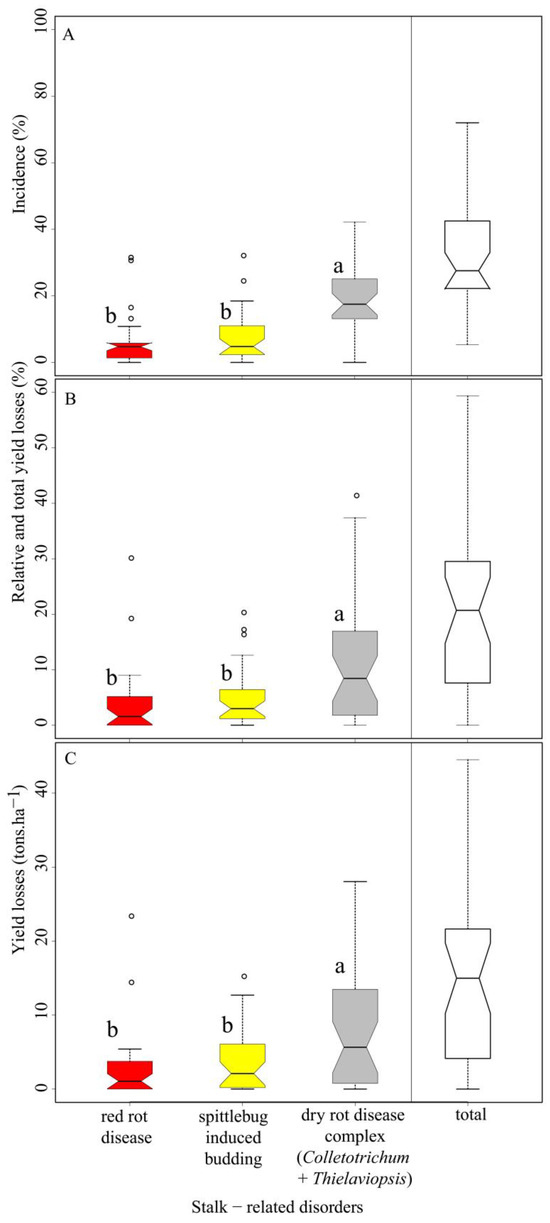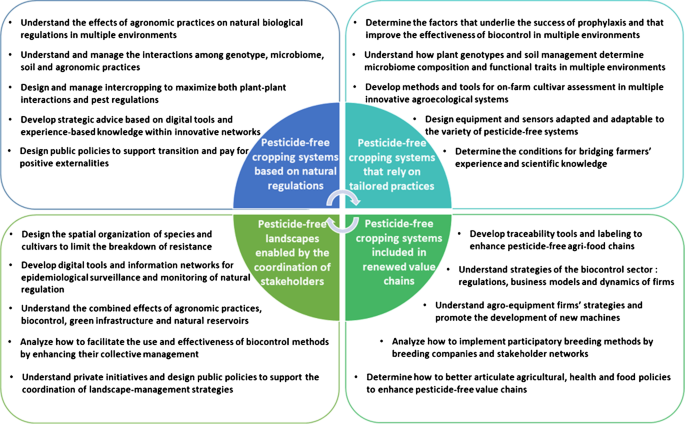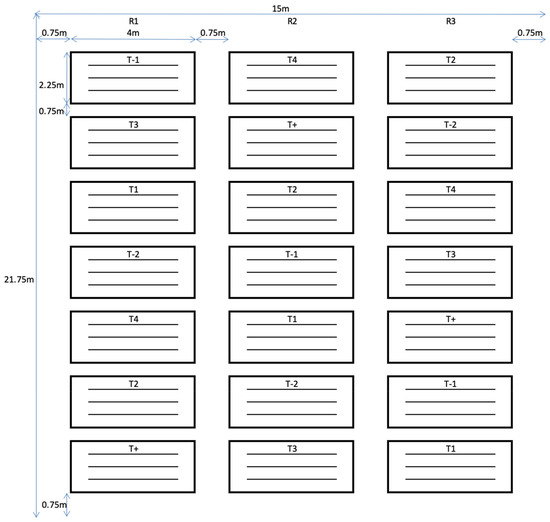Agronomy, Free Full-Text
Por um escritor misterioso
Last updated 05 novembro 2024

Sugarcane dry rot emerged as an important stalk disorder in newly expanded plantations in northwestern São Paulo, Brazil, under the current no-burning fully mechanical harvest policy gradually implemented in the past 20 years. This emergence was probably due to a considerable increase in both pathogen inocula and insect pest populations in sugarcane crop residues kept in the field. In this study, we surveyed the incidence of three stalk-related disorders in commercial sugarcane fields in six municipalities in northwestern São Paulo and the corresponding yield losses. The three stalk-related disorders surveyed were as follows: the red rot disease caused by the fungal pathogen Colletotricum falcatum, the spittlebug-induced shoot stunting, and the stem dry rot, which is associated with the simultaneous infection of C. falcatum and Thielaviopsis paradoxa, the pineapple set rot pathogen. Red rot disease was detected in 88.2% of the fields surveyed, while the spittlebug-induced shoot stunting disorder and the internal stem dry rot were found in 97.1% of the fields. Stem dry rot had the highest incidence and resulted in the highest yield losses. Total sugarcane yield losses were estimated at 20.1%, with an average of 14.2 (±3.8) t·ha−1 per field. The multiple regression model constructed to determine which of the three stem-related disorders contributed the most to total yield losses was not significant. Subsequently, the performance analyses of single-variable polynomial regression models indicated that the simple linear model was the best fit in terms of independently predicting sugarcane yield losses based on each stem-related disorder. Positive and significant correlations were only detected between sugarcane yield losses in t·ha−1 and the incidence of red rot disease or leafhopper-induced shoot stunting. We concluded that the stalk’s internal dry rot, as a disease complex associated with both C. falcatum and T. paradoxa, was the most important disorder in sugarcane fields in the northwest region of São Paulo state. A sustainable pest management program is needed to reduce the impact of all three stalk-associated disorders on regional sugarcane production.
PDF) A textbook on Fundamentals of Agronomy-I
Agronomy Journal: Vol 114, No 4

Agronomy Templates PSD Design For Free Download

Free Agriculture PowerPoint Templates & Slide Templates

Agriculture, Free Full-Text

Pesticide-free agriculture as a new paradigm for research

Agriculture Photos, Download The BEST Free Agriculture Stock

Agriculture, Economics and Nature

Celebrating Science & Innovation in Agriculture - Farming First

Radically Rethinking Agriculture for the 21st Century

Agronomist Cover Letter Example (Free Guide)

Agronomy, Free Full-Text
Recomendado para você
-
 vendo um comercio - Equipamentos e mobiliário - Infraero, Macapá 123956360605 novembro 2024
vendo um comercio - Equipamentos e mobiliário - Infraero, Macapá 123956360605 novembro 2024 -
HOTEL B&S, ⋆⋆⋆⋆, NOVA ANDRADINA, BRAZIL05 novembro 2024
-
 Secretaria de Turismo de Andradina05 novembro 2024
Secretaria de Turismo de Andradina05 novembro 2024 -
 Nova Andradina, Batayporã e Taquarussu são reconhecidas em premiação05 novembro 2024
Nova Andradina, Batayporã e Taquarussu são reconhecidas em premiação05 novembro 2024 -
ᐉ HOTEL TROPICAL ⋆⋆⋆ ( NOVA ANDRADINA, BRAZIL ) REAL PHOTOS & GREAT DEALS05 novembro 2024
-
 Urna para divisão de cinzas mini as - Urnas de Angeli05 novembro 2024
Urna para divisão de cinzas mini as - Urnas de Angeli05 novembro 2024 -
 Merca Frios Mini Box em Andradina, SP, Açougues05 novembro 2024
Merca Frios Mini Box em Andradina, SP, Açougues05 novembro 2024 -
 Cesta de Café da Manhã Mini Kit Matinal com Ramalhete de Rosas05 novembro 2024
Cesta de Café da Manhã Mini Kit Matinal com Ramalhete de Rosas05 novembro 2024 -
 Cesta Café da Manhã Mini Kit Matinal05 novembro 2024
Cesta Café da Manhã Mini Kit Matinal05 novembro 2024 -
 Mini necessaire PVC transparente zip 205 novembro 2024
Mini necessaire PVC transparente zip 205 novembro 2024
você pode gostar
-
 Wrestle Bros 🔥 Play online05 novembro 2024
Wrestle Bros 🔥 Play online05 novembro 2024 -
 DanceeMangoos Y2k Tops Y2k Aesthetic Tops Y2k Clothing Y2k Clothes Y2k Tops for Women 2000s Fashion05 novembro 2024
DanceeMangoos Y2k Tops Y2k Aesthetic Tops Y2k Clothing Y2k Clothes Y2k Tops for Women 2000s Fashion05 novembro 2024 -
Elemental Raiders – Apps no Google Play05 novembro 2024
-
 A Court of Thorns and Roses (A Court of Thorns and05 novembro 2024
A Court of Thorns and Roses (A Court of Thorns and05 novembro 2024 -
 Hell's Paradise: Jigokuraku Episode 1 English Subbed - BiliBili05 novembro 2024
Hell's Paradise: Jigokuraku Episode 1 English Subbed - BiliBili05 novembro 2024 -
 The Silver Guardian - Apple TV05 novembro 2024
The Silver Guardian - Apple TV05 novembro 2024 -
 Stone Ocean (Episode), JoJo's Bizarre Wiki05 novembro 2024
Stone Ocean (Episode), JoJo's Bizarre Wiki05 novembro 2024 -
 Resident Evil Zero – Wikipédia, a enciclopédia livre05 novembro 2024
Resident Evil Zero – Wikipédia, a enciclopédia livre05 novembro 2024 -
 Fact: If you know the rules of poker, you can make INSANELY HUGE amounts of MONEY with Video Poker present in all casinos. Choose the one with $5000 wager. It's a steal05 novembro 2024
Fact: If you know the rules of poker, you can make INSANELY HUGE amounts of MONEY with Video Poker present in all casinos. Choose the one with $5000 wager. It's a steal05 novembro 2024 -
 Enigma Club - O que saber antes de ir (ATUALIZADO 2023)05 novembro 2024
Enigma Club - O que saber antes de ir (ATUALIZADO 2023)05 novembro 2024
